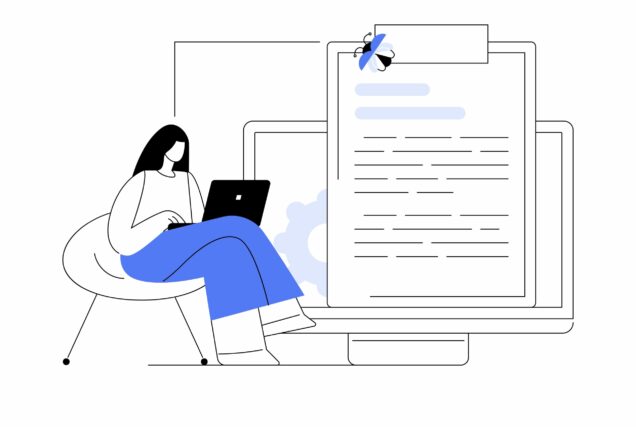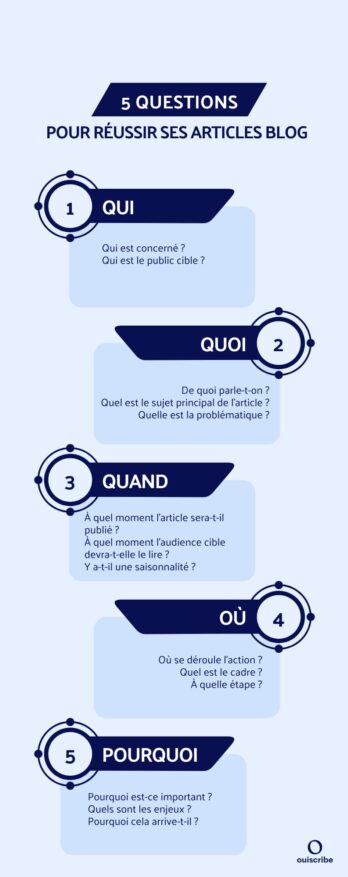5W method: writing well on the web
Bloggers, web editors or even site owners, do you want each of your articles to be a magnet for readers and search engines? Adopt the 5W method. Simple, but powerful! This writing technique inherited from journalism not only structures your content: it also boosts your natural referencing (SEO). By applying the principles of Who, What, Where, When and Why, you will captivate your readers and raise your pages to the top of search engines. Ready to discover the proven method for creating relevant texts that make a difference?

What is the 5W rule in web writing?
There 5W method structures content creation around five key questions: Who ? What ? Or ? When ? For what ?
This writing technique aims to organize information in a text and plan the questions that Internet users are asking. It is useful for all types of content, whether it is blog posts, web pages, advertisements or any other form of communication.
💡Did you know ? According to a study by the Nielsen Norman group, 79 % from Internet users simply skim the content of websites rather than reading it in detail.
This figure highlights the importance of a clear, concise and structured approach to content marketing. Thus, pages that apply the principles of the five Ws and respond precisely to user questions are more likely to rank. at the top of search results (Google, Bing, etc.) and convert their visitors.
The 5W method applied to blog articles
The Anglo-Saxon acronym “5W” refers to five question words:
- What
- Who
- Why
- Where
- When
They are essential for questioning (and covering) the subject of your article comprehensively. Let’s look at each of these elements in detail.
➡️ To do this, let's take the example of a blog article: "what are the benefits of walking?" »
# What : define the subject of your content
“What” reveals the heart of your blog post: the main idea, the product, the service or the event. This is your tool to clearly define the topic.
- What are we talking about ? Identify the overall theme.
- What is the main subject of the article? Highlight the most important aspect of your text.
- What is the problem? Determine the question or problem being addressed.
➡️ Let’s take our article on the benefits of walking: here, “What” refers to the main health benefits of walking. This is the central element of the article: the benefits of walking.
# Who : identify your target audience
In web writing, the “Who” targets the audience directly affected by your content, that is to say the persona.
- Who should be interested? Identify the Internet users that your subject touches or mobilizes.
- Who is your target audience? Define the typical profile of the readers your article is aimed at.
➡️ In our case, the “Who” of our article on the benefits of walking extends to people of all ages and fitness levels, wanting to improve their health and well-being.
# Or : determine the location
The “Where” question specifies the framework associated with your content, whether tangible or figurative.
- Where is something happening? Locate the event or action.
- What is the context? Shed more light on the environment where everything plays out.
- At what stage? Determine what stage of the process we are at.
➡️ For a live event, " Or " could point to a specific physical location. For digital content, it can refer to the platform or distribution channel, such as a website or social application.
In our article, although we can walk anywhere, we are going to recommend stimulating settings like parks, nature trails or even our own neighborhood.
# When : date the information
“When” illuminates the temporal context of your article content, with specific dates, periods or frequencies.
- When should the article be read? Identify the best time for your target audience to discover it.
- Should seasonality be taken into account? Consider the impact of certain periods or seasonal events and interest in your content.
➡️ In our walking example, “When” explores the ideal time to enjoy it, such as in the morning to boost energy, at midday for a regenerating break, or in the evening to relax after a busy day.
# For what : define the objective of your article
" For what " ? This key question uncovers the motivations and reasons behind the facts presented in your article.
- What is the purpose of the article? Set a clear goal.
- Why is this important? Highlight the importance and impact of your content.
- What are the issues ? Illustrate the consequences for readers or society in general.
- Why is this happening? Look for the causes or factors causing the situation.
➡️ In our article, the “Why” highlights the importance of walking for health and shows how to adopt it on a daily basis. It is a call to take care of yourself, encouraging everyone to take action for their well-being.

Common pitfalls to avoid
If the 5Ws are a valuable tool for creating SEO content, stay alert to avoid certain pitfalls which could limit its impact. Here are five points of attention:
1️⃣ Stay focused on the essential: remove superfluous details that could overshadow your main message.
2️⃣ Each answer to Who, What, Where, When and Why must relate to the subject covered.
3️⃣ Never underestimate the importance of " Why " : this is the key to captivating and engaging your target audience.
4️⃣ Don't forget to align your answers to the 5 questions with the needs and interests of your target audience, from start to finish!
5️⃣ Do not neglect the editorial quality : take care of your spelling, grammar and writing style.
What is the impact of the 5W method on SEO?
There is no no direct link between the 5Ws and SEO, but an indirect impact undeniable.
Indeed, by answering users' key questions using the 5-question rule, you produce relevant and engaging content. And so ? You thus promote a decrease in bounce rate and an user experience optimized, two key elements taken into account by Google in its ranking.
Additionally, the natural use of relevant keywords and lexical field in your answers to the 5 questions also contributes to improve SEO of your website.
In summary, apply the five questions and let your SEO skyrocket… without even thinking about it!
The 5 Ws and the 2 Cs (how and how much)
The five questions writing technique is a great place to start. But you can go further by also integrating the 2Cs: How and How Much. This approach is inspired by the QQOQCP method (What, Who, Where, When, How, Why, How much).
These two complementary questions allow ofdeepen the answers and provide even more precise and useful information to users.
➡️ How : detail the steps, processes, conditions, or methods related to your topic.
Example: how to start walking (good practices).
➡️ How much : add quantified data and comparisons to bring concreteness to your text.
Example: walking equipment budget.
With these 7 questions, you will write exhaustive content which fully meets the expectations of your target audience.
What you must remember
The 5W method is an essential tool web writing and content marketing. L'main objective is to help write clear and structured content for users. By answering the Who, What, Where, When and Why questions, you produce editorial content that is clear, relevant and captivating. The result ? You boost your online visibility, boost interactions with your audience and improve your natural referencing (SEO).
Share on
